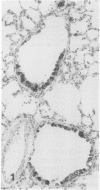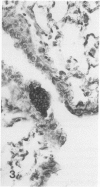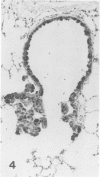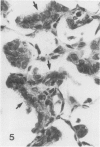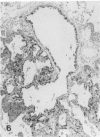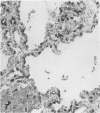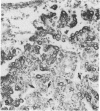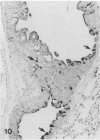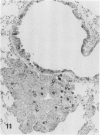Abstract
Both alveolar type II cells and Clara cells have been suggested as cells of origin of human bronchioloalveolar lung carcinomas and other pulmonary neoplasms, based on the presence of cell specific markers identified by immunocytochemical methods. Alveolar type II cell origin of solid and papillary lung tumors of the mouse has been demonstrated, and Clara cells have been suggested as cell of origin for hamster pulmonary neoplasms. Therefore, chemically induced bronchiolar hyperplasias and pulmonary neoplasms of Syrian golden hamsters were analyzed by avidin-biotin immunohistochemistry to localize a hamster-specific Clara cell antigen (CCA) and keratin. The hamsters had been treated subcutaneously with multiple doses of N-nitrosodiethylamine (NDEA). Proliferative lesions of low cuboidal, tall columnar, or pleomorphic cells were present within bronchioles or adjacent to airways in the alveolar parenchyma. Frequently areas of squamous cell differentiation were present focally or diffusely that were immunoreactive for cytokeratin. Immunoreactivity for cytokeratin was also noted for hyperplastic bronchiolar neuroepithelial bodies. Cellular hyperplasias extending out into the alveolar parenchyma contained ciliated cells and frequently consisted of cells immunoreactive for CCA, showing them to be of bronchiolar Clara cell origin. Tumors developed from bronchiolar cell hyperplasias localized within bronchioles and from bronchiolar cells lining former alveolar walls. Neoplastic growth patterns were tubulo-papillary, forming loose networks or densely cellular areas. Immunoreactivity for cytoplasmic CCA was found in 50% of the tumors and was seen most frequently in small cuboidal cells and larger, vacuolated cells scattered throughout the neoplasms. In summary, evidence is presented that NDEA-induced pulmonary tumors of the Syrian golden hamster originated from cells lining bronchioles and from extrabronchiolar Clara cell hyperplasias of the terminal bronchioles. As the pulmonary tumors of the hamsters progressed towards a squamoid cell type, CCA was no longer detectable but cells became immunoreactive for keratin.
Full text
PDF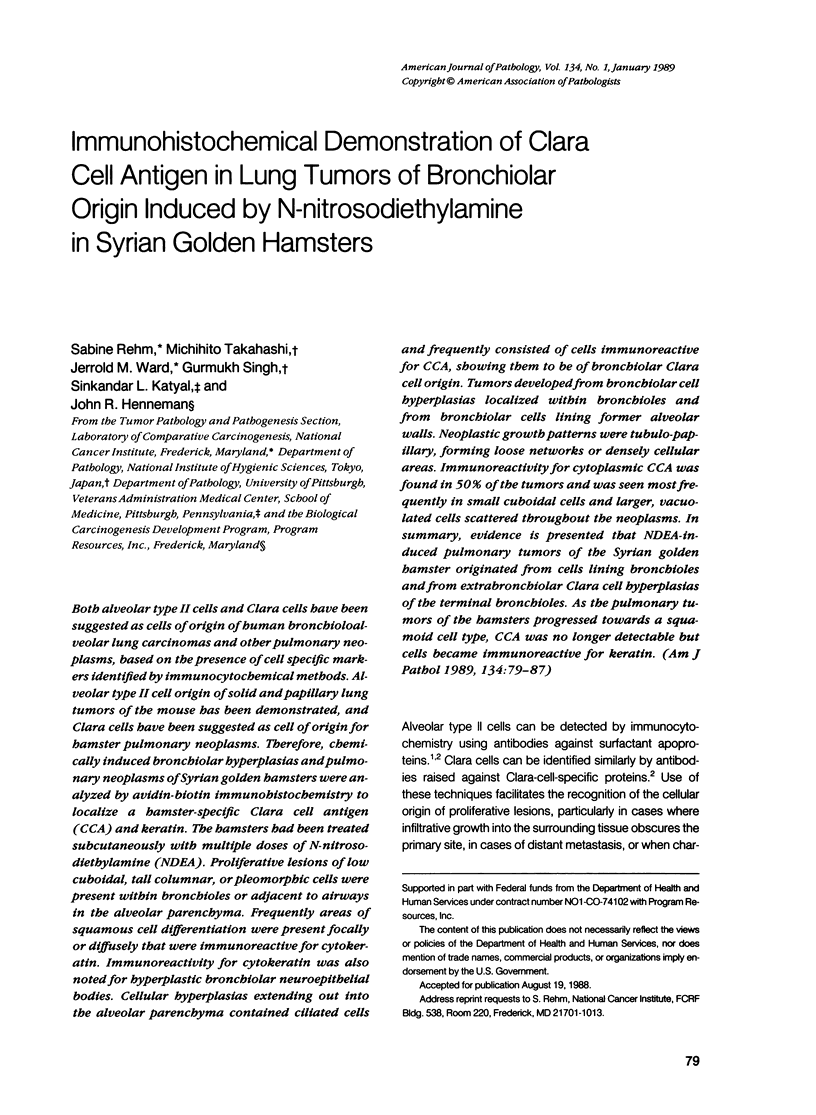
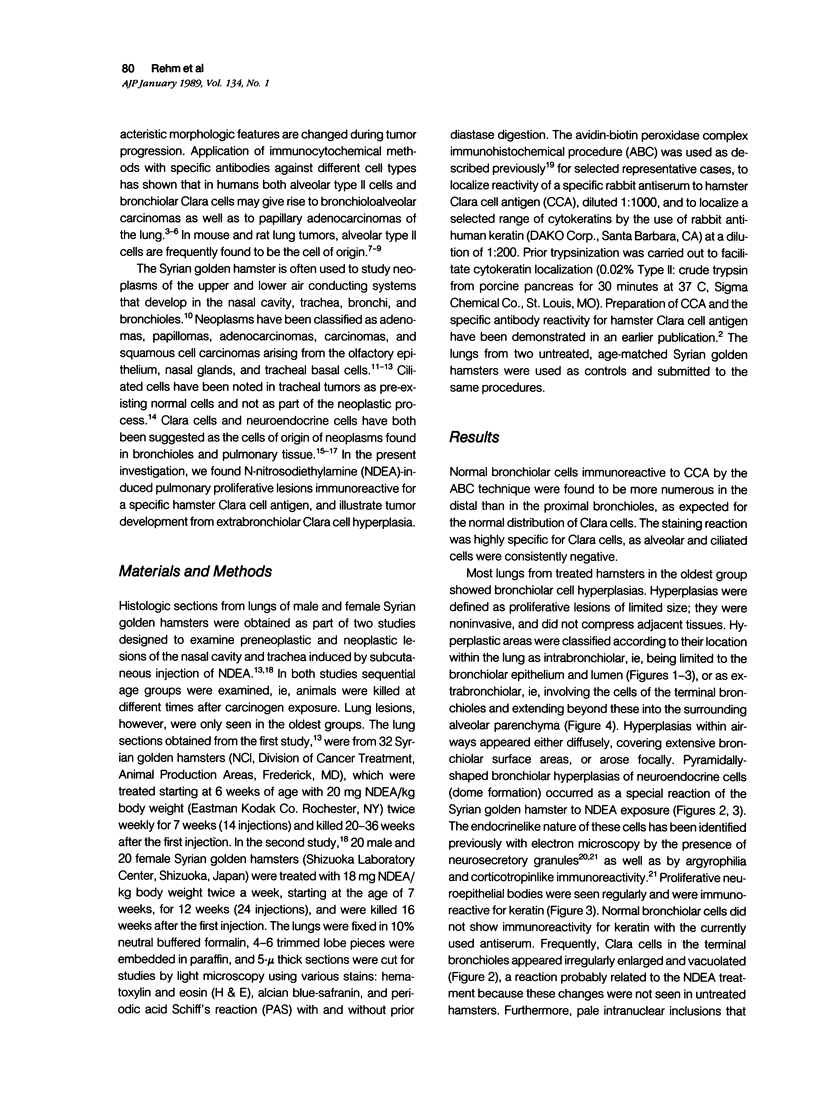

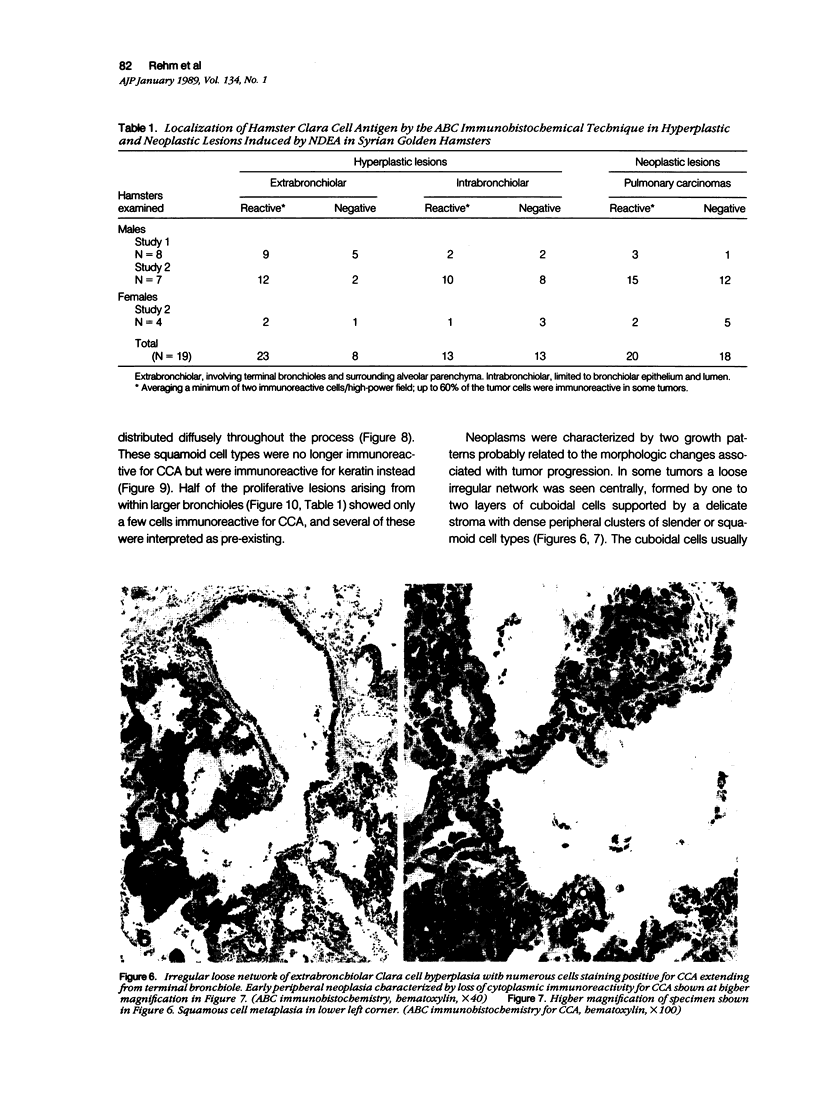
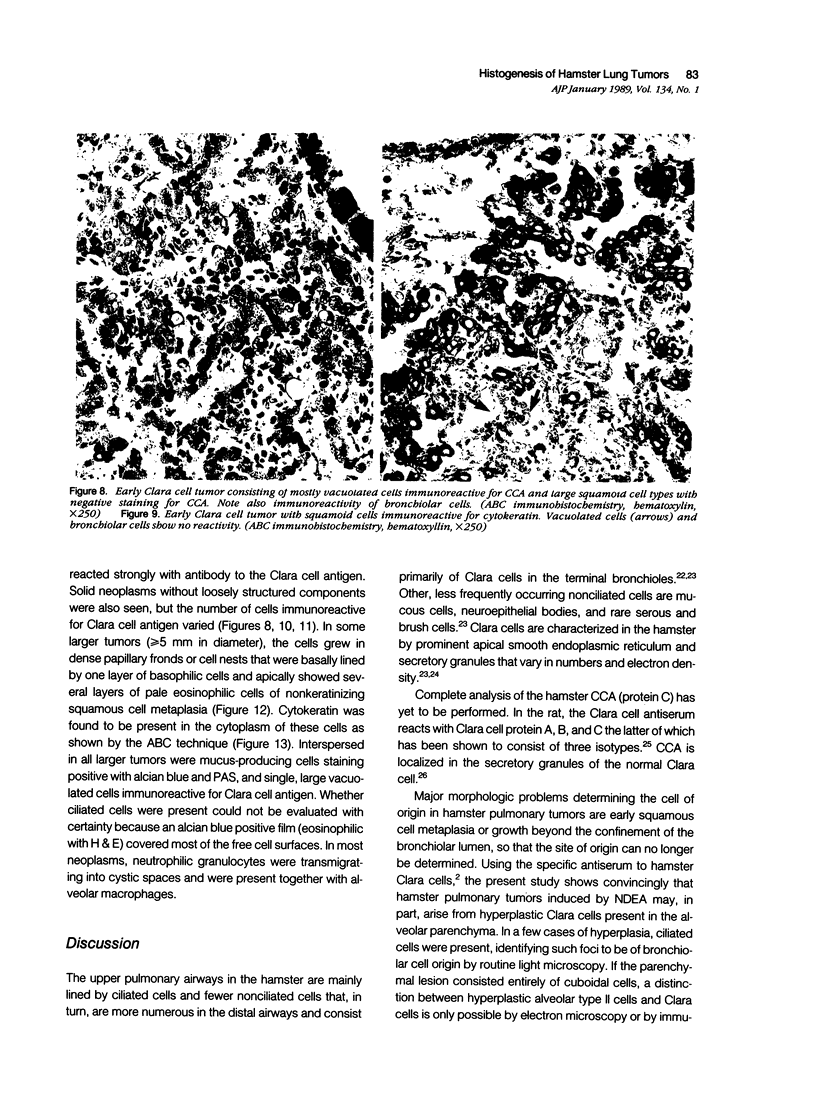
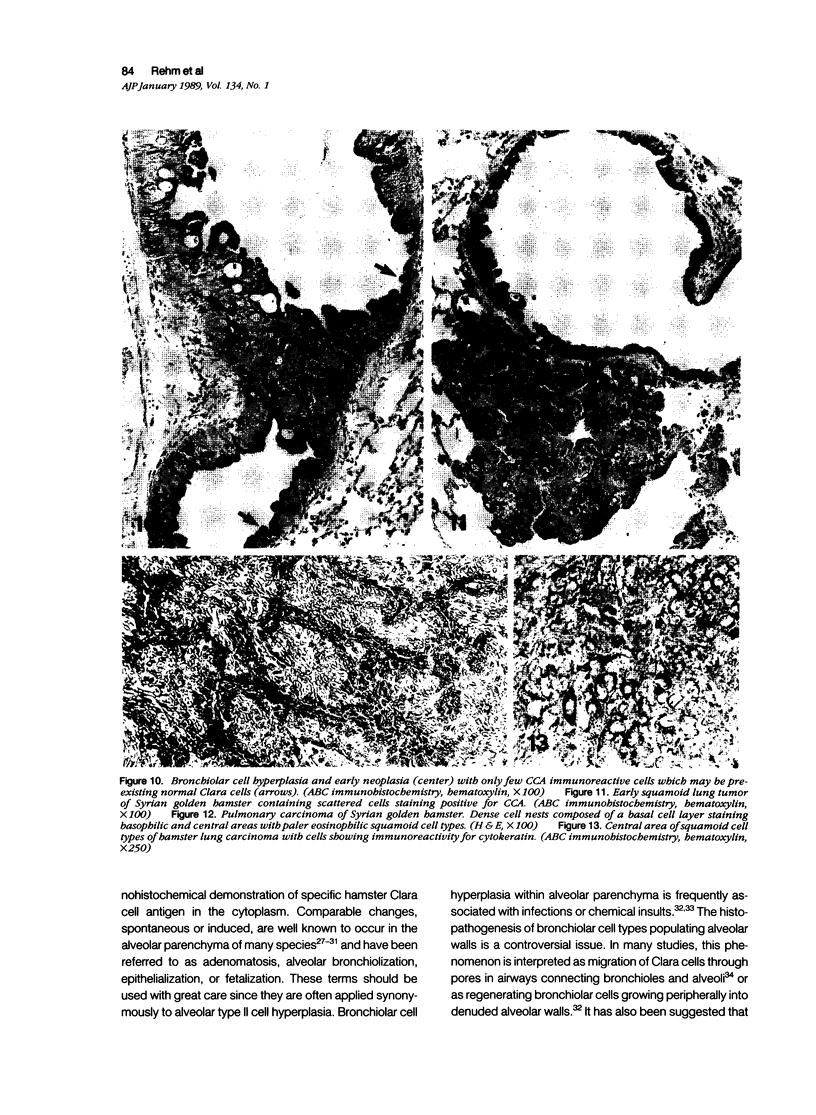

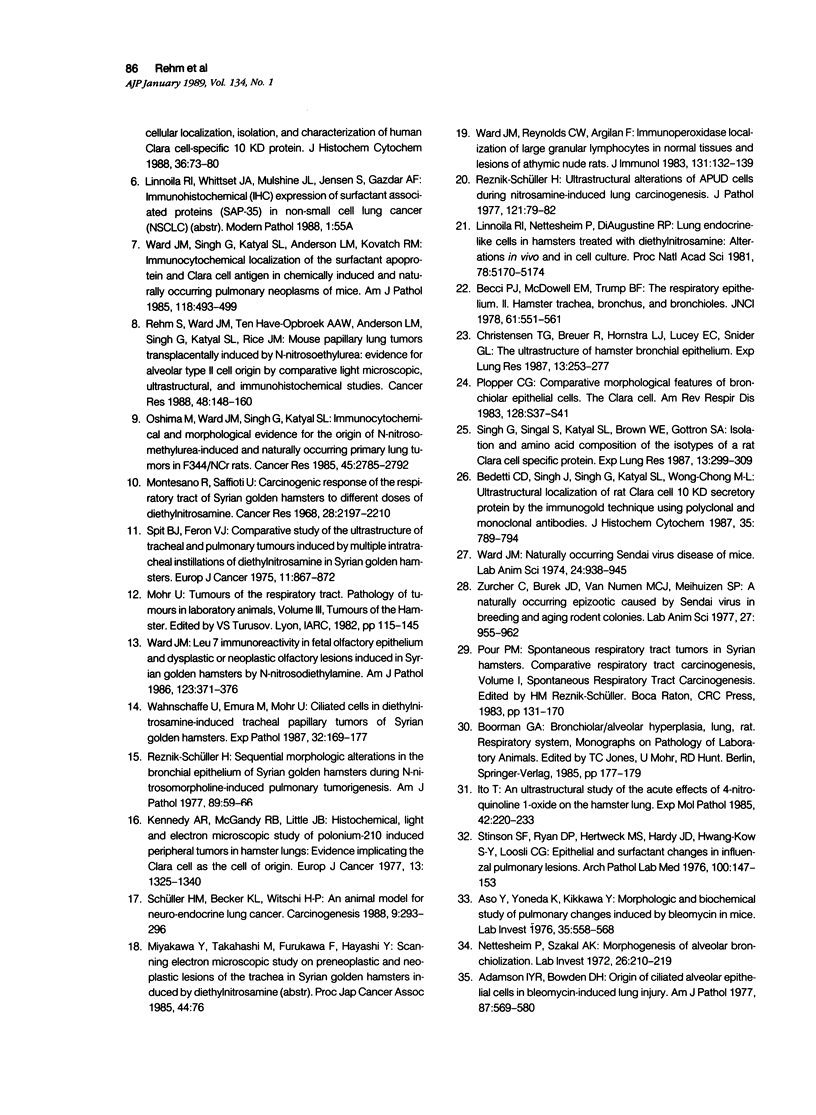
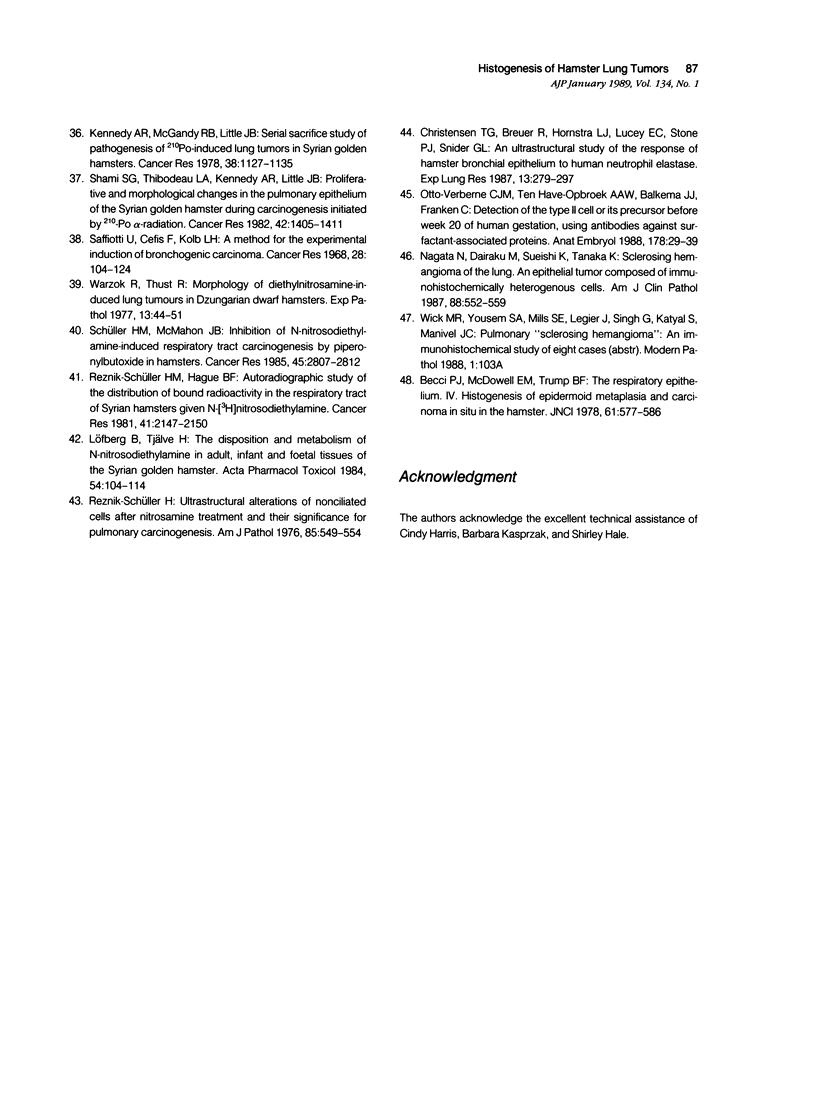
Images in this article
Selected References
These references are in PubMed. This may not be the complete list of references from this article.
- Adamson I. Y., Bowden D. H. Origin of ciliated alveolar epithelial cells in bleomycin-induced lung injury. Am J Pathol. 1977 Jun;87(3):569–580. [PMC free article] [PubMed] [Google Scholar]
- Aso Y., Yoneda K., Kikkawa Y. Morphologic and biochemical study of pulmonary changes induced by bleomycin in mice. Lab Invest. 1976 Dec;35(6):558–568. [PubMed] [Google Scholar]
- Becci P. J., McDowell E. M., Trump B. F. The respiratory epithelium. II. Hamster trachea, bronchus, and bronchioles. J Natl Cancer Inst. 1978 Aug;61(2):551–561. [PubMed] [Google Scholar]
- Becci P. J., McDowell E. M., Trump B. F. The respiratory epithelium. IV. Histogenesis of epidermoid metaplasia and carcinoma in situ in the hamster. J Natl Cancer Inst. 1978 Aug;61(2):577–586. [PubMed] [Google Scholar]
- Bedetti C. D., Singh J., Singh G., Katyal S. L., Wong-Chong M. L. Ultrastructural localization of rat Clara cell 10 KD secretory protein by the immunogold technique using polyclonal and monoclonal antibodies. J Histochem Cytochem. 1987 Jul;35(7):789–794. doi: 10.1177/35.7.2438324. [DOI] [PubMed] [Google Scholar]
- Christensen T. G., Breuer R., Hornstra L. J., Lucey E. C., Snider G. L. The ultrastructure of hamster bronchial epithelium. Exp Lung Res. 1987;13(3):253–277. doi: 10.3109/01902148709069593. [DOI] [PubMed] [Google Scholar]
- Christensen T. G., Breuer R., Hornstra L. J., Lucey E. C., Stone P. J., Snider G. L. An ultrastructural study of the response of hamster bronchial epithelium to human neutrophil elastase. Exp Lung Res. 1987;13(3):279–297. doi: 10.3109/01902148709069594. [DOI] [PubMed] [Google Scholar]
- Ito T. An ultrastructural study of the acute effects of 4-nitroquinoline 1-oxide on the hamster lung. Exp Mol Pathol. 1985 Apr;42(2):220–233. doi: 10.1016/0014-4800(85)90029-2. [DOI] [PubMed] [Google Scholar]
- Kennedy A. R., McGandy R. B., Little J. B. Histochemical, light and electron microscopic study of polonium-210 induced peripheral tumors in hamster lungs: evidence implicating the Clara cell as the cell of origin. Eur J Cancer. 1977 Nov;13(11):1325–1340. doi: 10.1016/0014-2964(77)90043-3. [DOI] [PubMed] [Google Scholar]
- Kennedy A. R., McGundy R. B., Little J. B. Serial sacrifice study of pathogenesis of 210Po-induced lung tumors in Syrian golden hamsters. Cancer Res. 1978 Apr;38(4):1127–1135. [PubMed] [Google Scholar]
- Linnoila R. I., Nettesheim P., DiAugustine R. P. Lung endocrine-like cells in hamsters treated with diethylnitrosamine: alterations in vivo and in cell culture. Proc Natl Acad Sci U S A. 1981 Aug;78(8):5170–5174. doi: 10.1073/pnas.78.8.5170. [DOI] [PMC free article] [PubMed] [Google Scholar]
- Löfberg B., Tjälve H. The disposition and metabolism of N-nitrosodiethylamine in adult, infant and foetal tissues of the Syrian golden hamster. Acta Pharmacol Toxicol (Copenh) 1984 Feb;54(2):104–114. doi: 10.1111/j.1600-0773.1984.tb01902.x. [DOI] [PubMed] [Google Scholar]
- Mizutani Y., Nakajima T., Morinaga S., Gotoh M., Shimosato Y., Akino T., Suzuki A. Immunohistochemical localization of pulmonary surfactant apoproteins in various lung tumors. Special reference to nonmucus producing lung adenocarcinomas. Cancer. 1988 Feb 1;61(3):532–537. doi: 10.1002/1097-0142(19880201)61:3<532::aid-cncr2820610319>3.0.co;2-8. [DOI] [PubMed] [Google Scholar]
- Montesano R., Saffiotti U. Carcinogenic response of the respiratory tract of Syrain golden hamsters to different doses of diethylnitrosamine. Cancer Res. 1968 Nov;28(11):2197–2210. [PubMed] [Google Scholar]
- Nagata N., Dairaku M., Sueishi K., Tanaka K. Sclerosing hemangioma of the lung. An epithelial tumor composed of immunohistochemically heterogenous cells. Am J Clin Pathol. 1987 Nov;88(5):552–559. doi: 10.1093/ajcp/88.5.552. [DOI] [PubMed] [Google Scholar]
- Nettesheim P., Szakal A. K. Morphogenesis of alveolar bronchiolization. Lab Invest. 1972 Feb;26(2):210–219. [PubMed] [Google Scholar]
- Ohshima M., Ward J. M., Singh G., Katyal S. L. Immunocytochemical and morphological evidence for the origin of N-nitrosomethylurea-induced and naturally occurring primary lung tumors in F344/NCr rats. Cancer Res. 1985 Jun;45(6):2785–2792. [PubMed] [Google Scholar]
- Otto-Verberne C. J., Ten Have-Opbroek A. A., Balkema J. J., Franken C. Detection of the type II cell or its precursor before week 20 of human gestation, using antibodies against surfactant-associated proteins. Anat Embryol (Berl) 1988;178(1):29–39. doi: 10.1007/BF00305011. [DOI] [PubMed] [Google Scholar]
- Plopper C. G. Comparative morphologic features of bronchiolar epithelial cells. The Clara cell. Am Rev Respir Dis. 1983 Aug;128(2 Pt 2):S37–S41. doi: 10.1164/arrd.1983.128.2P2.S37. [DOI] [PubMed] [Google Scholar]
- Rehm S., Ward J. M., ten Have-Opbroek A. A., Anderson L. M., Singh G., Katyal S. L., Rice J. M. Mouse papillary lung tumors transplacentally induced by N-nitrosoethylurea: evidence for alveolar type II cell origin by comparative light microscopic, ultrastructural, and immunohistochemical studies. Cancer Res. 1988 Jan 1;48(1):148–160. [PubMed] [Google Scholar]
- Reznik-Schüller H. M., Hague B. F., Jr Autoradiographic study of the distribution of bound radioactivity in the respiratory tract of Syrian hamsters given N-[3H]nitrosodiethylamine. Cancer Res. 1981 Jun;41(6):2147–2150. [PubMed] [Google Scholar]
- Reznik-Schüller H. Sequential morphologic alterations in the bronchial epithelium of Syrian golden hamsters during N-nitrosomorpholine-induced pulmonary tumorigenesis. Am J Pathol. 1977 Oct;89(1):59–66. [PMC free article] [PubMed] [Google Scholar]
- Reznik-Schüller H. Ultrastructural alterations of APUD cells during nitrosamine-induced lung carcinogenesis. J Pathol. 1977 Feb;121(2):79–82. doi: 10.1002/path.1711210203. [DOI] [PubMed] [Google Scholar]
- Reznik-Schüller H. Ultrastructural alterations of nonciliated cells after nitrosamine treatment and their significance for pulmonary carcinogenesis. Am J Pathol. 1976 Dec;85(3):549–554. [PMC free article] [PubMed] [Google Scholar]
- Saffiotti U., Cefis F., Kolb L. H. A method for the experimental induction of bronchogenic carcinoma. Cancer Res. 1968 Jan;28(1):104–124. [PubMed] [Google Scholar]
- Schuller H. M., Becker K. L., Witschi H. P. An animal model for neuroendocrine lung cancer. Carcinogenesis. 1988 Feb;9(2):293–296. doi: 10.1093/carcin/9.2.293. [DOI] [PubMed] [Google Scholar]
- Schuller H. M., McMahon J. B. Inhibition of N-nitrosodiethylamine-induced respiratory tract carcinogenesis by piperonylbutoxide in hamsters. Cancer Res. 1985 Jun;45(6):2807–2812. [PubMed] [Google Scholar]
- Shami S. G., Thibodeau L. A., Kennedy A. R., Little J. B. Proliferative and morphological changes in the pulmonary epithelium of the Syrian golden hamster during carcinogenesis initiated by 210Po alpha alpha-radiation. Cancer Res. 1982 Apr;42(4):1405–1411. [PubMed] [Google Scholar]
- Singh G., Katyal S. L., Torikata C. Carcinoma of type II pneumocytes: immunodiagnosis of a subtype of "bronchioloalveolar carcinomas". Am J Pathol. 1981 Feb;102(2):195–208. [PMC free article] [PubMed] [Google Scholar]
- Singh G., Katyal S. L., Ward J. M., Gottron S. A., Wong-Chong M. L., Riley E. J. Secretory proteins of the lung in rodents: immunocytochemistry. J Histochem Cytochem. 1985 Jun;33(6):564–568. doi: 10.1177/33.6.3889141. [DOI] [PubMed] [Google Scholar]
- Singh G., Singal S., Katyal S. L., Brown W. E., Gottron S. A. Isolation and amino acid composition of the isotypes of a rat Clara cell specific protein. Exp Lung Res. 1987;13(3):299–309. doi: 10.3109/01902148709069595. [DOI] [PubMed] [Google Scholar]
- Spit B. J., Feron V. J. Comparative study of the ultrastructure of Tracheal and pulmonary tumours induced by multiple intratracheal instillations of diethylnitrosamine in Syrian golden hamsters. Eur J Cancer. 1975 Dec;11(12):867–872. doi: 10.1016/0014-2964(75)90086-9. [DOI] [PubMed] [Google Scholar]
- Stinson S. F., Ryan D. P., Hertweck S., Hardy J. D., Hwang-Kow S. Y., Loosli C. G. Epithelial and surfactant changes in influenzal pulmonary lesions. Arch Pathol Lab Med. 1976 Mar;100(3):147–153. [PubMed] [Google Scholar]
- Wahnschaffe U., Emura M., Mohr U. Ciliated cells in diethylnitrosamine-induced tracheal papillary tumors of Syrian golden hamster. Exp Pathol. 1987;32(3):169–177. doi: 10.1016/s0232-1513(87)80047-6. [DOI] [PubMed] [Google Scholar]
- Ward J. M., Argilan F., Reynolds C. W. Immunoperoxidase localization of large granular lymphocytes in normal tissues and lesions of athymic nude rats. J Immunol. 1983 Jul;131(1):132–139. [PubMed] [Google Scholar]
- Ward J. M. Leu 7 immunoreactivity in fetal olfactory epithelium and dysplastic or neoplastic olfactory lesions induced in Syrian golden hamsters by N-nitrosodiethylamine. Am J Pathol. 1986 May;123(2):371–376. [PMC free article] [PubMed] [Google Scholar]
- Ward J. M. Naturally occurring Sendai virus disease of mice. Lab Anim Sci. 1974 Dec;24(6):938–942. [PubMed] [Google Scholar]
- Ward J. M., Singh G., Katyal S. L., Anderson L. M., Kovatch R. M. Immunocytochemical localization of the surfactant apoprotein and Clara cell antigen in chemically induced and naturally occurring pulmonary neoplasms of mice. Am J Pathol. 1985 Mar;118(3):493–499. [PMC free article] [PubMed] [Google Scholar]
- Worzok R., Thust R. Morphology of diethylnitrosamine-induced lung tumours in Dzungarian dwarf hamsters. Exp Pathol (Jena) 1977;13(1):44–51. doi: 10.1016/s0014-4908(77)80029-x. [DOI] [PubMed] [Google Scholar]
- Zurcher C., Burek J. D., Van Nunen M. C., Meihuizen S. P. A naturally occurring epizootic caused by Sendai virus in breeding and aging rodent colonies. I. Infection in the mouse. Lab Anim Sci. 1977 Dec;27(6):955–962. [PubMed] [Google Scholar]
- ten Have-Opbroek A. A. Immunological study of lung development in the mouse embryo. Appearance of a lung-specific antigen, localized in the great alveolar cell. Dev Biol. 1975 Oct;46(2):390–403. doi: 10.1016/0012-1606(75)90115-3. [DOI] [PubMed] [Google Scholar]



